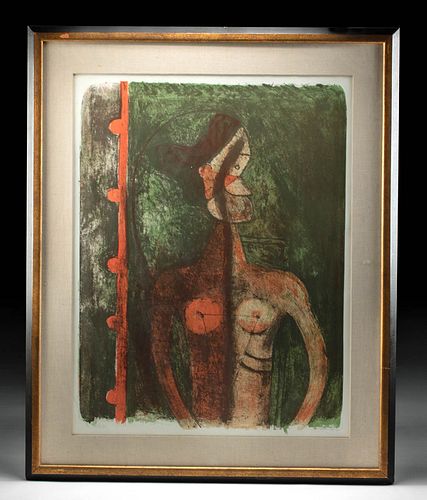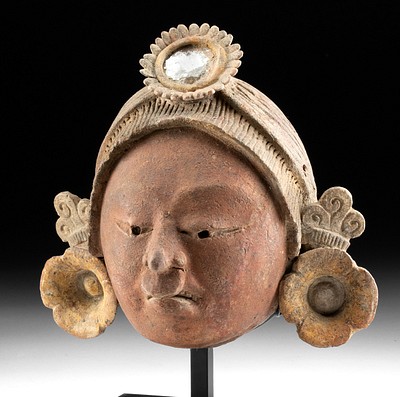Framed Signed Tamayo Lithograph "Torso de Joven" 1969
Lot 184
About Seller
Artemis Gallery
686 S Taylor Ave, Ste 106
Louisville, CO 80027
United States
Selling antiquities, ancient and ethnographic art online since 1993, Artemis Gallery specializes in Classical Antiquities (Egyptian, Greek, Roman, Near Eastern), Asian, Pre-Columbian, African / Tribal / Oceanographic art. Our extensive inventory includes pottery, stone, metal, wood, glass and textil...Read more
Categories
Estimate:
$2,000 - $3,000
Absentee vs Live bid
Two ways to bid:
- Leave a max absentee bid and the platform will bid on your behalf up to your maximum bid during the live auction.
- Bid live during the auction and your bids will be submitted real-time to the auctioneer.
Bid Increments
| Price | Bid Increment |
|---|---|
| $0 | $25 |
| $300 | $50 |
| $1,000 | $100 |
| $2,000 | $250 |
| $5,000 | $500 |
| $10,000 | $1,000 |
| $20,000 | $2,500 |
| $50,000 | $5,000 |
| $100,000 | $10,000 |
| $200,000 | $20,000 |
About Auction
By Artemis Gallery
Jul 14, 2022
Set Reminder
2022-07-14 10:00:00
2022-07-14 10:00:00
America/New_York
Bidsquare
Bidsquare : Exceptional Antiquities Ethnographica Fine Art
https://www.bidsquare.com/auctions/artemis-gallery/exceptional-antiquities-ethnographica-fine-art-9692
Museum-worthy examples of classical antiquities (Egyptian, Greek, Roman, Near Eastern), Viking, Far East / Asian, Pre-Columbian, African / Tribal, Oceanic, Native American, Spanish Colonial, Fossils, Ancient Jewelry, Fine / Visual Arts, so much more! Artemis Gallery info@artemisgallery.com
Museum-worthy examples of classical antiquities (Egyptian, Greek, Roman, Near Eastern), Viking, Far East / Asian, Pre-Columbian, African / Tribal, Oceanic, Native American, Spanish Colonial, Fossils, Ancient Jewelry, Fine / Visual Arts, so much more! Artemis Gallery info@artemisgallery.com
- Lot Description
Rufino Tamayo (Mexican, 1899-1991). "Torso de Joven" lithograph in colors, 1969. Printed by Desjobert, Paris. Published by Touchstone Publishers, Ltd, New York. Ed. 117/150. Hand signed at the lower right and hand numbered (117/150) and lower left. Rufino Tamayo's "Torso de Joven" (Torsof of a Youth) presents an abstract nude with a front facing torso, round breasts, and an inverted triangle with upper corners strategically positioned at the nipples and the lower one pointing toward the locus of genitalia. The ghostly profile visage features a simple circle for an eye, a pale complexion, and a stylized brunette coiffure. The almost macabre body is marked by a bold blood red line that runs from forehead to abdomen, and a striking brighter, scarlet red line with circular nodules runs in parallel beside the figure. The figure's pale flesh is embellished with peachy white and strawberry red hues which dramatically contrast with the dark green background. A mesmerizing piece by Rufino Tamayo, one of the most respected Modern Mexican artists along with his peers Diego Rivera, David Alfaro Siqueiros, and Jose Clemente Orozco. Size of image: 26.75" L x 20.75" W (67.9 cm x 52.7 cm) Size of frame: 35.875" L x 29.125" W (91.1 cm x 74 cm)
Rufino Tamayo was an innovator known for his graphic work in several media including etchings, woodcuts, lithographs, aquatints, and mixografia prints. Tamayo emerged as an artist in the early 20th century when a nationalist movement known as "indigenismo" was very popular among Mexican modernists who were inspired by the indigenous cultures of their heritage. In addition to being a prolific visual artist, Tamayo was a pure Zapotec Indian who subscribed to the philosophy of indigenismo and also became head of the department of ethnographic drawing at the National Museum of Archaeology in Mexico City in 1926. He studied at the Academy of San Carlos from 1917 to 1922 and moved to New York City in 1937 where he showed at Knoedler and Marlborough Galleries. Tamayo was also embraced by the international community at the 1950 Venice Biennale where he exhibited his paintings. He then lived in Paris for ten years before returning to his native Mexico where he erected a museum in his home town of Oaxaca. Rufino Tamayo's work as a painter, muralist, and printmaker represents the oeuvre of a true exemplar of the rich Mexican fine art tradition. His work has been displayed all over the globe in reputable museums including The Solomon R. Guggenheim Museum, New York City, The Phillips Collection, Washington D.C., and the Museo Nacional Centro de Arte Reina Sofia, Madrid. This piece is a wonderful example from his remarkable body of work.
Provenance: ex-Nancy and Dr. E.F. Simpson collection, Los Angeles, California, USA, acquired from 1970 to 2000
All items legal to buy/sell under U.S. Statute covering cultural patrimony Code 2600, CHAPTER 14, and are guaranteed to be as described or your money back.
A Certificate of Authenticity will accompany all winning bids.
PLEASE NOTE: Due to recent increases of shipments being seized by Australian & German customs (even for items with pre-UNESCO provenance), we will no longer ship most antiquities and ancient Chinese art to Australia & Germany. For categories of items that are acceptable to ship to Australia or Germany, please contact us directly or work with your local customs brokerage firm.
Display stands not described as included/custom in the item description are for photography purposes only and will not be included with the item upon shipping.
#172179Hand signed in pencil at the lower right and hand numbered (117/150) in pencil at lower left, this lithograph in colors is set in an attractive custom frame. It has not been examined outside the frame but appears to be in excellent condition. Minor scuffs to the frame, but it is otherwise very nice, wired for suspension, and ready to display.Condition
- Shipping Info
-
All shipping is handled in-house for your convenience. Your invoice from Artemis Gallery will include shipping calculation instructions. If in doubt, please inquire BEFORE bidding for estimated shipping costs for individual items.
-
- Buyer's Premium



 EUR
EUR CAD
CAD AUD
AUD GBP
GBP MXN
MXN HKD
HKD CNY
CNY MYR
MYR SEK
SEK SGD
SGD CHF
CHF THB
THB














